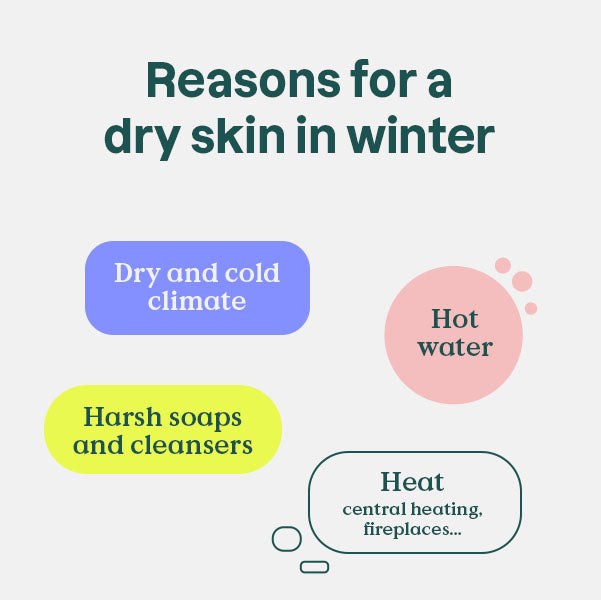
Our body deserves extra tender loving care during those cold blustery days. The shift from warm weather to cold, crisp temperatures can take a toll on our skin, hair and scalp. Cold air and strong winds, coupled with indoor heating and plummeting humidity, can zap our skin’s moisture and lead to dry flaky skin, itchy scalp and brittle hair.
While switching up your seasonal skin care ritual may seem daunting, it doesn’t have to be difficult. A few simple adjustments to your beauty regimen can go a long way. Read on to find out what causes dry skin and three simple tips to help you keep your hair and skin healthy and hydrated naturally in the gloomier months, no matter what the environment throws your way.
What causes dry skin during winter?
Our skin is coated with a thin protective layer called the hydrolipidic film, which consists of an aqueous part and an oily part. Its main functions are to protect against external aggressions and to create an occlusive effect to maintain the natural hydration of the skin. Dryness occurs when our skin’s natural barrier is compromised and lacks the adequate amount of moisture on its outer surface, i.e. the epidermis.
Of course, external factors such as environmental pollutants, extreme hot/cold temperatures, and low humidity can negatively impact your skin’s natural balance.

Dry skin can be triggered by1:
- Weather or fluctuations in temperature: Our skin tends to dry out in extremely dry or cold climates, when temperatures and humidity levels drop.
- Heat: Central heating, wood-burning stoves and fireplaces all reduce humidity and dry out your skin.
- Hot water: Taking long, hot showers or baths can dry out your skin.
- Harsh soaps and cleansers: Many popular soaps, detergents and shampoos can actually strip moisture from your skin and dry it out.
Symptoms of dry skin can start with a feeling of discomfort or that your skin is “pulling”. They can also include itchiness and chapping, redness and irritation, as well as skin tightness and flakiness. Areas frequently exposed to outdoor elements such as the arms, hands, elbows, face and scalp, tend to be more affected by dry skin. Luckily, skin discomfort and tightness can easily be addressed in just a few steps.

Tip #1 – Switch up your skin care routine
We often wait to see symptoms of dry skin before taking action. But the best way to prep and protect our skin and hair for winter is to amp up our daily personal care routine before the cold weather sets in, so as to prevent and minimize damage and irritation.
Our skin’s needs vary according to the climate and season. And during winter, it requires extra care and nourishment because of drier temperatures. Your favorite summer moisturizer may not suffice as you transition into winter; as the outdoor humidity drops, so does your skin’s moisture. So it’s time to double up on the hydration!
Avoid using the same products year-round; instead, adapt your daily routine to the season and the changing needs of your skin. You’ll most likely need thicker, richer and more soothing skin care products in the winter compared to the warmer, more humid months. A rich moisturizer is essential to help you keep your skin feeling soothed, and less uncomfortable throughout the day, and is better suited to mitigate the effects of harsh weather.
Your skin needs a moisturizer that acts as a barrier on the skin to prevent moisture loss and keep your cells hydrated.
Pro tip:
If your skin needs extra hydration, we recommend switching from lightweight formulas to use an oil-based gentle face cleansers instead, as well as a moisturizing shower gel to keep your skin fresh and glowing and to stimulate elasticity. Don’t forget to apply a hydrating eye cream to help soothing eyelid dryness.
Tip #2 – Stock up on winter skin and hair essentials
Your scalp, just like your skin, is susceptible to weather fluctuations. While some people may experience dandruff during winter, others develop more oily scalps because of their body’s mechanism to produce more sebum to compensate for excess dryness 2.
If you have a more oily scalp, use a clarifying shampoo once a week to help remove excess sebum. For dryer scalps, choose a nourishing shampoo and conditioner containing nourishing ingredients like shea butter or avocado oil.
These ultra-nourishing ingredients are easily absorbed into your skin and protect it from external aggressors such as wind or cold. Apply a body lotion containing these ingredients right after bathing, in the morning and before bedtime. You can also apply the oils directly on your hair as an overnight deep-conditioning treatment once or twice a week for ultimate hydration.
Pro tip:
Apply a moisturizer to your body and face at least twice daily (especially right after you shower), and always carry a nourishing hand cream with you, and apply regularly. Don’t forget to apply a lip balm daily to help sooth lip dryness.
Tip #3 – Cool down on the hot water!

When it’s cold, we tend to spike up the water temperature to compensate for the chilly weather. However, this causes your blood vessels to dilate in order to release heat, resulting in more water evaporation, which in turn causes your skin to be more susceptible to dryness and irritation 3.
Although stepping into a warm bath can be comforting on a cold winter day, hot water can also strip your body of its natural oils and dry up your hair shaft and skin. To prevent that from occurring, we recommend bathing in warm or lukewarm water and shortening your shower sessions to 10 minutes or less. Lastly, avoid bathing more than once a day.
Nourishing ingredients we love:
1. Shea butter
Shea butter’s rich texture is packed with essential fatty acids to keep your skin in good condition. Moreover it is high in vitamins A and E, and it softens skin. Skin care or hair care products containing shea butter create a protective barrier on your skin and offer natural protection against winter damage.
2. Avocado oil
Avocado oil is an excellent emollient and skin softener. It’s packed with antioxidants and fatty acids improve dry skin appearance and helps preserve hydratation - all the more reason to use it during winter! Non-greasy and fast-absorbing, when added to a daily nourishing lotion, avocado oil will revitalize skin and keep it in good condition.
3. Argan oil
Full of antioxidants and fatty acids,argan oil is revered for its moisturizing and nourishing properties. It also has protective properties to deeply soothe dry skin and keep your hair feeling soft and bouncy.
4. Coconut oil
Coconut oil is known for its versatility: fast-acting, absorbent and lightweight, it restores skin suppleness and improves the appearance of dry skin. High in vitamin E and lauric acid, it can be used daily to moisturize every part of your body and condition your hair.
5. Oatmeal and chamomile
Calming for the skin, these two conditioning agents are known to soothe the sensation of itchy scalp and skin and to make hair smooth and shiny. They help soften skin, while increasing its suppleness.
Pro tip:
Opt for dermatologically-tested products with clean ingredients according to EWG. Choose moisturizing skin care and hair care products that help protect your skin against inclement weather, and that do not cause dryness.
Conclusion

When it comes to winter, seasonal skin care is the way to go. Your skin undergoes a lot of changes during winter, so implementing a simple and efficient skin care regimen comprised of natural, highly nourishing ingredients like the ones mentioned above is crucial to prevent dry skin.
When to see a doctor
While most symptoms of dry skin can be easily treated with simple home remedies and an adequate natural skin care routine, you should consult your doctor if:
- Our skin’s condition doesn’t improve over time.
- Your dry skin is accompanied by persistent redness or patches.
- If you scratch/itch frequently and/or experience bleeding.
- You have severe flaking, scaling or peeling skin.
Sources:
- https://www.mayoclinic.org/diseases-conditions/dry-skin/symptoms-causes/syc-20353885
- https://www.schweigerderm.com/?s=oily+skin
- https://www.huffingtonpost.ca/entry/shower-mistakes-to-avoid_us_56c764eae4b041136f16d8eb